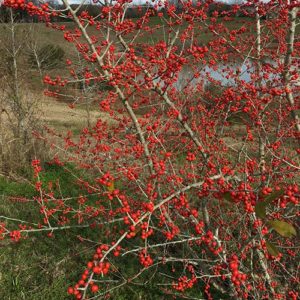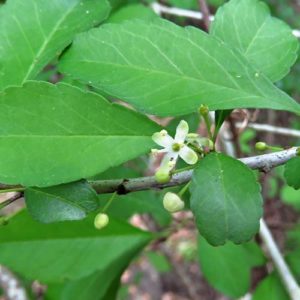Possumhaw (Ilex decidua) has many common names including deciduous holly, swamp holly, and prairie holly. It is also sometimes called winterberry, but be aware that “winterberry” is more commonly used in reference to Ilex verticillata, which is also a deciduous holly. To make things more complicated, Ilex verticillata is sometimes called “deciduous holly,” even though that common name is more commonly applied to possumhaw. Grr…common names are nice, but they can quickly become frustrating and confusing.
Personally, I love the common name possumhaw, and that is the name I most often use for Ilex decidua. First, it’s just fun to say, and second, I don’t know of anything else that is called possumhaw so it’s a pretty safe bet that we’re talking about the same plant. The other common name I sometimes use for possumhaw is deciduous holly, but then we get into the potential confusion with winterberry which I discussed above.
Whatever you want to call it, possumhaw is native to parts of Alabama, Arkansas, Florida, Georgia, Illinois, Indiana, Kansas, Kentucky, Louisiana, Maryland, Missouri, Mississippi, North Carolina, Oklahoma, South Carolina, Tennessee, Texas, Virginia. In the wild, it is most commonly found in relatively moist soils, often in bottomlands. It isn’t a plant for higher elevations. One U.S. Forest Service reference I found indicated that it is typically found below around 1,200 feet in elevation.

Possumhaw is a tall shrub or small tree. It usually grows to 10-15 feet tall, but can get taller. According to the U.S. Forest Service, in 1981 the largest known possumhaw was in South Carolina and was 42 feet tall with a 3-foot circumference. However, the National Register of Champion Trees no longer has an entry for possumhaw. Although, possumhaw sometimes grows in a single-trunked tree shape, it will often form multi-trunked thickets as well.
Like most hollies, possumhaw is dioecious meaning that it has separate male and female trees. Both produce relatively small, creamy white flowers in the spring, typically in the April – May timeframe. The female plants will then produce berries that ripen to bright red in the fall. The ripe berries may stay on the tree all winter if they aren’t eaten.
One surprising fact about possumhaw is that it loses its leaves in the winter. It’s this characteristic that gives possumhaw its scientific name, Ilex (the genus of all hollies) decidua (meaning deciduous). That’s also why one of its common names is deciduous holly. There are a handful of other native hollies that are also deciduous, but most species of hollies are the evergreen plants that we more commonly think about when someone says “holly.”
Pollinator and Wildlife Uses:
Hollies in general, including possumhaw, can be valuable for wildlife and pollinators. Holly flowers are highly attractive to a wide variety of bees and butterflies. Members of this genus are also the host plants for the caterpillars of several moth and butterfly species. Deer and other mammalian herbivores will sometimes nibble at the leaves and twigs, but hollies typically aren’t a preferred food source. (This can be an advantage in landscaped settings with high deer populations.) Many different species of wildlife including opossums (thus the common name), raccoons, turkeys and a wide variety of songbirds will eat possumhaw’s fruit, especially later in the winter.
Incorporating Possumhaw into Your Yard:
Possumhaw likes part shade to full sun. In landscaped settings, it has been reported to grow in dry to moist soils. However, I would tend to stick to moister areas to more closely mimic its natural soil preferences. The edge of a rain garden, a lower spot in the yard, or even by the downspout might all be good choices. You’ll probably also be ok in medium moisture soil, but if you plant it in a drier area, then make sure you can water it, if it needs it during dry spells.
If you want the bright red berries, then you’ll need to plant multiples trees. One male possumhaw can fertilize multiple female possumhaws. Unfortunately, the flowers or the presence of fruit are the only ways to tell the sex of the tree. So, if you are buying seedlings or smaller trees, which tend to be cheaper than larger trees and often do better in the long run, then you probably won’t know whether you are getting male or female trees. Buying more than two trees increases your odds of getting at least one of each sex.

Possumhaw can either be used as a specimen tree or used for a hedge. Some individuals will naturally take on a multi-trunk growth form which helps with the hedge formation, if that is the style you are going for. If you prefer more of a single-trunk “tree shape,” then you can prune it as necessary to maintain that shape.
Finding possumhaw can be a bit of a challenge. It isn’t as commonly sold as some of our other native plants. If your state’s forestry department has a tree nursery, then check with them. Also check with any native plant nurseries in your area or that you find online. Some will have possumhaw; others won’t. You may have to do a little hunting to find possumhaw, but it can be worth it.
There are also a few cultivars on the market so there is a chance that you might find one of those at a more traditional nursery. However, even the cultivars of possumhaw aren’t as popular as some other species, so you may still have to hunt a little bit to find one As a general rule, I prefer straight, wild-type plants over cultivars, but sometimes cultivars are easier to find than wild-type specimens and that can be an important consideration.
With cultivars of any native plant, there is sometimes the question of whether wildlife and pollinators will use them as much as wild-type specimens or if the cultivars provide the same nutritional compliment as wild-type individuals. Unfortunately, this is something that almost has to be looked at on a case-by-case basis for each cultivar. I’m not aware of any studies that have specifically looked at those questions in regard to any of the possumhaw cultivars.
Summary:
Possumhaw is a native deciduous holly in much of the southeastern U.S. It can also be grown as a specimen tree or as a hedge in a landscaped setting. Like other hollies, its flowers and fruits can be an abundant source of food for local pollinators and wildlife. The bright red berries can also provide abundant winter interest in your yard or garden. Although it might not be the easiest species to find in the horticulture trade, it is definitely worth considering if you are looking for a unique tall shrub or short tree that will provide lots of winter interest while also benefiting your local bees, butterflies, and wildlife.
Please tell your friends about Backyard Ecology.
(Social media sharing buttons can be found below the footer.)

Backyard Ecology: Exploring Nature in Your Backyard
Nature isn’t just “out there.” It’s all around us, including right outside our doors. Hi, my name is Shannon Trimboli, and I am the host of Backyard Ecology. I live in southcentral Kentucky and am a wildlife biologist, educator, author, beekeeper, and owner of a nursery specializing in plants for pollinators and wildlife conservation. I invite you to join me as we ignite our curiosity and natural wonder, explore our yards and communities, and improve our local pollinator and wildlife habitat. Learn more or subscribe to my email list at www.backyardecology.net.

Leave a Reply